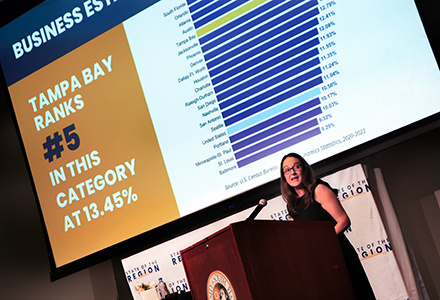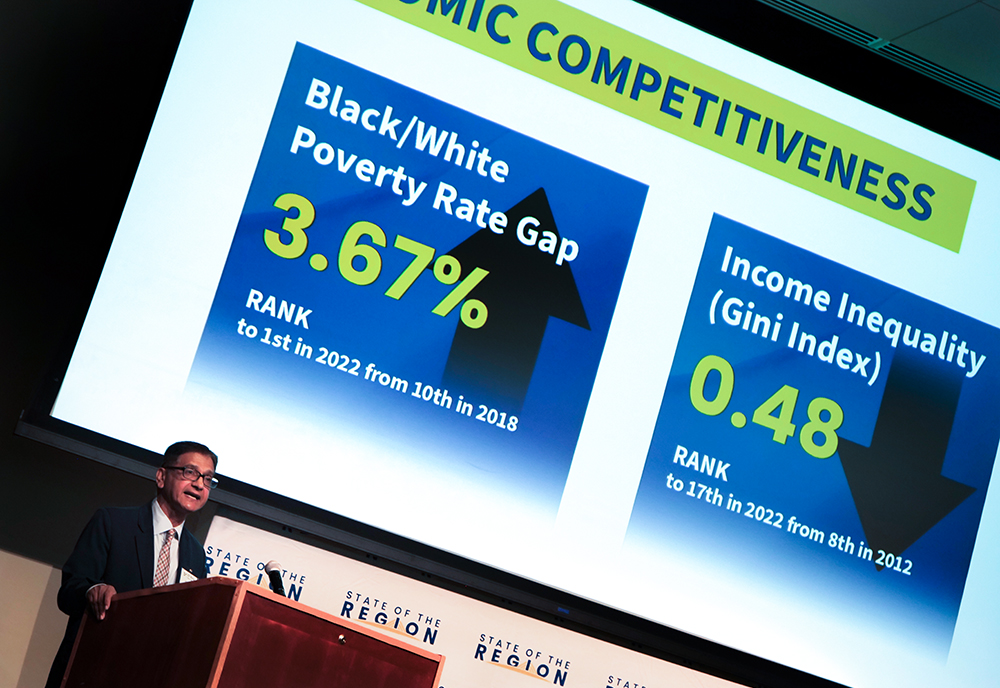TAMPA – Once again, new residents are flocking to the Tampa Bay area.
On the flip side, family budgets are squeezed, with nearly 57 cents of every dollar
going toward housing and transportation. That financial strain reveals an alarming
narrative — full-time work is not enough to make ends meet. Households are pulling
from their savings to cover the gap.
These are some of the economic realities driving workforce and affordability trends
in the Tampa Bay region as detailed by two economic competitiveness reports released
today by researchers from the University of South Florida Muma College of Business
and the Tampa Bay Partnership.
The highlights, as well as some declining trend lines, were revealed at the seventh State of the Region community luncheon held on USF’s Tampa campus.
The two data-driven reports show how the area compares with 19 similar metropolitan communities. Some of the main findings from the 2024 Tampa Bay E-Insights Report and the 2024 Regional Competitiveness Report show:
- Wages are not keeping pace with the cost of living, making earning a college degree a financial necessity. Consider these two data points: 79% of jobs that pay more than $60,000 require a college degree. And a family of four with two kids in childcare must earn at least $82,348 to make ends meet.
- Tampa Bay topped its competitors in closing the poverty rate gap.
- Attending college in Tampa Bay is a bargain. Students graduate with some of the lowest debt and graduate tuition is the most budget friendly option among its metropolitan peers.
Close to 350 business leaders, community organizers and government officials attended the annual event. For the past seven years, USF and the Tampa Bay Partnership have teamed up to create the two complementary benchmarking reports.

“These reports have evolved into trusted tools employed by leaders to galvanize resources and unite efforts,” said Jean Kabongo, associate dean for academic affairs and accreditation at the USF Muma College of Business.
“Use a critical lens and make note of where your organization can activate around
these critical issues. Systems change is a team sport, and we need all hands on deck
to make Tampa Bay the best it can be.”
Researchers with the USF Muma College of Business produced the 2024 Tampa Bay E-Insights Report, a 68-page report that focuses on three key areas: economic outcomes, affordability,
and talent pipeline. The Tampa Bay Partnership, in collaboration with Community Foundation
Tampa Bay and United Way Suncoast, created the 2024 Regional Competitiveness Report.
“By convening and activating leaders from the eight counties of Tampa Bay, we can
achieve what no one individual and no one organization can accomplish alone,” said
Bemetra Simmons, president and CEO of Tampa Bay Partnership.
Overall, the Tampa Bay region showed a year-over-year improvement in 34 of the 67
indicators in the partnership’s report.
During Monday’s 90-minute event, researchers took turns explaining the data as moderators held a “Fireside Chat” with an invited business leader.
Affordability trends
Among the economic affordability trends, researchers revealed:
- Tampa Bay ranks first in net migration, with a significant jump of 2.8% and a strong business start rate.
- Average wages grew by nearly $3,500 or close to 6%, exceeding the U.S. average.
- The region is seeing decreases in overall poverty rates, yet more full-time workers are struggling to make ends meet.
“As we continue to attract new residents to the region, ensuring that wages keep up with the cost of living will become more and more important,” said Lucia Farriss, the senior director of research, analytics, and public policy, at the Tampa Bay Partnership.

USF’s Shivendu Shivendu, an associate professor in the School of Information Systems and Management, said
their research analyzes real-time and traditional data to provide another perspective
about the region’s competitiveness.
He said this year’s results were mixed.
“While we have done great in reducing the racial inequity in terms of the Black-white
poverty gap by ranking No. 1 in 2022, the bad news is that our position in terms of
income inequality worsened, dropping from No. 8 to No. 17,” he said.

Ginger Chambless, the head of research for commercial banking at JPMorgan Chase, weighed
in with her perspective on affordability trends from a national lens.
She talked about the economy, consumer spending, and the dynamics of the national
labor market.
“Interest rates have basically gone from low to high in a short amount of time,” she
said. “The consumer is still in a pretty good place. They are not buying as many home-related
items, but are spending on travel.”
Workforce Trends
Among the economic indicators that explored the talent pipeline, researchers revealed:
- High school graduation rates worsened, falling four spots to No. 14 at 86.07%.
- Kindergarten readiness is moving in the right direction, but just over half of Tampa Bay students are prepared for kindergarten.
- Third-grade reading levels decreased to 47.7%, over seven percentage points behind Jacksonville, the leading Florida metro area.
“The reason this is so important for our future talent pool is that through third grade, students are learning to read,” said Farriss. “But after third grade, our students read to learn, and success here carries them through the rest of their academic journey, including graduating from high school.”

Farriss said the cost of childcare is also affecting the workforce.
The Florida Chamber of Commerce found that childcare issues resulted in an estimated
$5.4 billion loss to the state economy, and 15% of parents with young children have
left the workforce due to accessibility challenges, Farriss said.
Shivendu shared some positive news: Tampa Bay is one of the most affordable regions
to go to college. In fact, the region has the lowest in-state graduate tuition rate
among its metropolitan peers.
“This is great because it helps in the production of a high-caliber workforce which in turn helps in creating and attracting high paying jobs,” he said.
A Call to Action
Brian Auld, president for the Tampa Bay Rays and Rowdies and current chair of the Tampa Bay Partnership, said the community has a lot to celebrate, but also areas for improvement to ensure everyone has opportunities for long-term success.

“Our children are lagging behind peers in early education,” Auld said. “As we learned today, those indicators are vital factors for long-term success. We should celebrate our wins, but we need to lean into our opportunities for improvement. But we also need to be clear-eyed about our challenges.”
For those interested in a deeper dive into the research, an online “Ask the Researchers” session is set for Feb. 23 where attendees can connect with the researchers, ask questions or delve into any particular areas of interest. To attend the session, register here.
